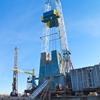
Methane gas emissions are commonplace in the oil and gas industry, mainly at gas wells where hydraulic fracturing takes place. Fracking is when a mixture of water, sand and chemicals are blasted down a well to break up shale formations, allowing the gas to flow. Methane gas is also present in natural gas, liquefied natural gas and petroleum systems.
According to the U.S. Environmental Protection Agency, methane is the second most prevalent greenhouse gas emission in the country, accounting for almost 10 percent of all emissions. Methane emissions also account for 60 percent of global emissions from human activities.
The oil and gas industry and petroleum systems are the largest source for methane gas emissions, the EPA said. Methane gas is commonly released into the air via methane leaks in gas wells. Companies in the oil and gas industry can reduce methane gas emissions by upgrading production, storage and transportation equipment to prevent leaks.
Between 1990 and 2010, methane emissions from the exploration and production of natural gas and petroleum increased in the United States, signaling a need for additional safety measures regarding workers who are at the well sites and may be exposed to the gas.
Dangers of methane exposure
A danger of methane is the properties of the product. With no odor, it can be found as a colorless, compressed or even liquefied gas, according to the U.S. Department of Labor's Occupational Safety and Health Administration.
Methane can react violently with chlorine dioxide and liquid oxygen as well as a number of other hazardous chemicals. Methane gas is also flammable, which presents extra dangers when heat is present in areas such as gas fields.
When employees are exposed to methane gas there are a number of symptoms that can be present. These symptoms include drowsiness and unconsciousness, the OSHA said.
Companies in the oil and as industry should not only concentrate on the reduction of methane gas emissions but also on protecting employees. If workers are injured on the job as the result of methane gas exposure or poisoning, the OSHA has the ability to open an investigation into the possibility of safety violations. Citations issues by OSHA as the result of violations can lead to penalties including fines.
Safety equipment such as combustible gas leak detectors can alert employees to increased levels of methane gas presence.
Industrial Safety News brought to you by Safety Systems Technology, Inc., leaders in fire and gas detection systems.